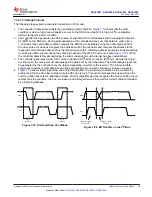
7.4.5 Application-Specific Modes
This section provides the details of application-specific functional modes available in the DACx300x.
7.4.5.1 Voltage Margining and Scaling
Voltage margining or scaling is a primary application for the DACx300x. This section provides specific features
available for this application such as Hi-Z output, slew-rate control, PROTECT input, and PMBus compatibility.
7.4.5.1.1 High-Impedance Output and PROTECT Input
All the DAC output channels remain in a high-impedance state (Hi-Z) when VDD is off.
simplified schematic of the DACx300x used in a voltage-margining application. Series resistor R
S
is required in
voltage-output mode, but is optional in current-output mode. Almost all linear regulators and DC/DC converters
have a feedback voltage of ≤ 1.25 V. The low-leakage currents at the outputs are maintained for V
FB
of ≤
1.25 V. Thus, for all practical purposes, the DAC outputs appear as Hi-Z when VDD of the DAC is off in voltage
margining and scaling applications. This feature allows for seamless integration of the DACx300x into a system
without any need for additional power-supply sequencing for the DAC.
DAC
V
IN
V
REG
R
1
R
2
R
S
V
FB
Linear
Regulator
or
DC/DC
Converter
VDD
1.25 V
Z
OUT
I
LEAK
PROTECT
Figure 7-9. High-Impedance (Hi-Z) Output and PROTECT Input
The DAC channels power down to Hi-Z at boot up. The outputs can power up with a preprogrammed code that
corresponds to the nominal output of the DC/DC converter or the linear regulator. This feature allows for smooth
power up and power down of the DAC without impacting the feedback loop of the DC/DC converter or the linear
regulator.
shows how the GPIO pin of the DACx300x can be configured as a PROTECT function. PROTECT
takes the DAC outputs to a predictable state with a slewed or direct transition. This function is useful in systems
where a fault condition (such as a brownout), a subsystem failure, or a software crash requires that the DAC
outputs reach a predefined state without the involvement of a processor. The detected event can be fed to
the GPIO pin that is configured as the PROTECT input. The PROTECT function can also be triggered using
the PROTECT bit in the COMMON-TRIGGER register.
shows how to configure the behavior of the
PROTECT function in the PROTECT-CONFIG field in the DEVICE-MODE-CONFIG register.
Note
• After the PROTECT function is triggered, the write functionality is disabled on the communication
interface until the function is completed.
• The PROTECT-FLAG bit in the CMP-STATUS register is set to 1 when the PROTECT function
is triggered. This bit can be polled by reading the CMP-STATUS register. After the PROTECT
function is complete, a read command on the CMP-STATUS register resets the PROTECT-FLAG
bit.
Table 7-4. PROTECT Function Configuration
PROTECT-CONFIG FIELD
FUNCTION
00
Switch to Hi-Z power-down (no slew).
01
Switch to DAC code stored in NVM (no slew) and then switch to Hi-Z power-down.
10
Slew to margin-low code and then switch to Hi-Z power-down.
11
Slew to margin-high code and then switch to Hi-Z power-down.
DAC53001, DAC53002, DAC63001, DAC63002
SLASF48 – MAY 2022
36
Copyright © 2022 Texas Instruments Incorporated
Product Folder Links:
















































